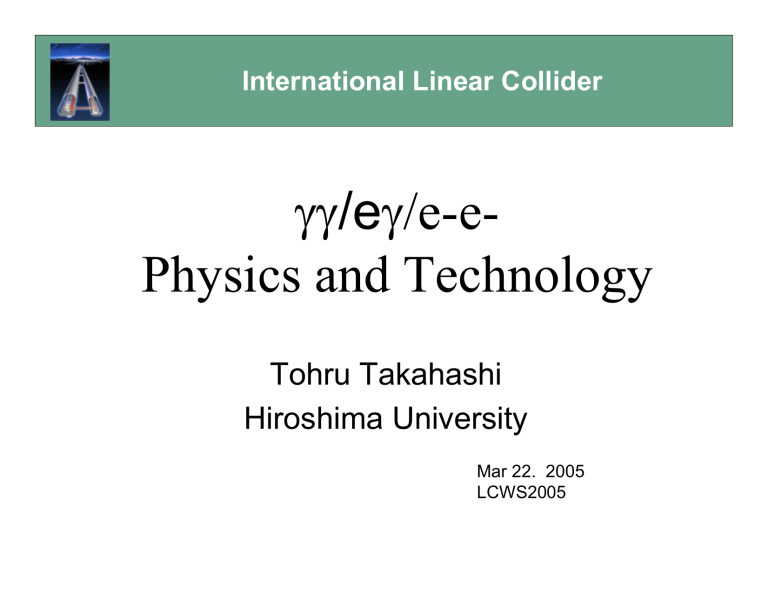γγ/eγ/e-e- Physics and Technology
advertisement

International Linear Collider γγ/eγ/e-eGamma-Gamma Options Physics and Technology Tohru Takahashi Hiroshima University Mar 22. 2005 LCWS2005 Principle of γγ, eγ , e-e-Collider e beam laser cp e beam ip laser Spectrum, polarization, depends on electron/laser polarization γ h γ Jz=0 electron polarization is essential this workshop • 4 sessions – 3 for physics – 1 for technology • Physics Hot topic in this WS – 8 talks on γγ, 2 for eγ • 6 for Higgs related • WW,μμ+ν, • Technology – How to accommodate options – impact of the “COLD” on the γγ/eγ technology Physics: Improvement γ h/H/A γ • Γ(h->γγ)Br(h->bb) for SM ,,,,,Niezuraski • γγ->H->bb in MSSM,,,,,,,,,,,,,,Niezurawski collider as would work as advertised – asγγrealistic possible – QCD bg, OE, x-angle, ww bg, tuning of cuts • Γ(h->γγ)Br(h->bb) for SM ,,,,,,,,,Rosca – Shapa,,, event generator for qqg • Precise calculation for γγ->WW->4f,,,,Dittamier – including radiative correction important as γγ collider is a W factory dκ,λ measurement,BG Physics: New Ideas h/H/A s-channel production of Higgs • CP phase in cMSSM via Γ(h->γγ)Br(h->bb) – sensitive to complex MSSM • γγ->H/A mixing in polarization: CP 2HDM,,,,,,,Choi collider – Utilize Linear γγ Polarization! provides Jz=0/2 or • γγ->A->H+W- in 2HDM,,,,,,,,,,,,,,Asakawa CP odd/even γγ Initial • Charge asymmetry in γγ-> states μμ νν ,,,,,,,Ginzburg – signal for new physics • Charge asymmetry in eγ-> eWW,,,,Ginzburg – a probe for strong interacting sector Technology • What are specific for γγ/eγ J.Gronberg • e-e- beam (polarization) K.Moenig optics Laser • Beam optics • Beam Crossing angle electron V.Telnov • Beam dump disrupted ecollimated γ • Lasers • Laser Optics Q magnet Y.Honda Beam parameters frep Hz nb ILC optimistic 5 ILC w/ e+e5 NLC γγ 120 e+e5 2820 2820 95 2820 same emittance(dumping ring) , nm 88/4.3 175/4.3 166/3.0 553/5 σx*/σy * tune final focus to achieve small spot size β x*/β y * mm 1.5/0.3 1.5/0.3 4/0.08 11/0.4 ε xn /ε yn μm rad 2.5/0.03 10/0.03 3.6/0.071 10/0.03 ee -2 -1 Lgeom cm s 11.8x10 33 5.9x10 34 4.0x10 34 34 1.6x10 •very important that the baseline use standard ILC parameters Gronberg Crossing angle consideration for γγ • Bottom line Laser θ d ≈ 10mr θd RQ e- θ x = θ d + θQ θQ = RQ L* θ d ≈ 10mr θQ θQ L* QD0 beam simulation depend on QD and FF optics θx Compensation Coils Brett Parker Crossing angle 2mr •20mr may be possible but need investigation •e+e- luminosity depends on Bz distrubution 20mr,,, strawman design of detector solenoid but or for γγ? 25 mr looks OK for all detector conecpt. Telnov note: e-e- mode is not operative at 2 mr as can not let the outgoing beam through final doublet. Lasers ~3000 bunches/1 ms need to amplify (feed energy to) 3000 pulses in 1ms electrons <- SCRF Solid state Laser <- none way out ,,,,,,, construct Hi Q (pulse stacking ) cavity out side the laser A Detector with Cavity 100m long pulse laser cavity K. Moeing Short pulse stacking cavities are under development • Y. Honda et al. KEK – 7 ps pulses – Developed for laser wire application • A good start, but… – Nowhere near γγ power levels – Nowhere near γγ small laser focus – Nowhere near γγ cavity size ~20m Y. Honda J. Gronberg - LLNL LCWS 2005 – Stanford – March 18-22, 2005 Issues for Snowmass IR layout , final focus for θx =20mr (25mr ): • – • beam dump design for disrupted beam and collimated photons. – – – • minimize horizontal beta function full beam tracking FF to beam dump detector background and masks compatibility with e+e- detector Design pulse cavity ,,,,, need laser optics person • • • • • feed back stability damage nonlinear index compatibility with e+e- detector Get ILC community(BDS, detector) agreed with the design Summary • Why – Optional operation is desired for all physics case. • When/How long should we run options? – Physics will tell us,,, not a current issue. • How ,,,,,,, issue to be discussed now – to share accelerator w/ e+e– to share detectors – to develop laser sytem • who will work on – synergetic w/ base ILC program – BDS, detectors, polarimeters, laser wire, pol. e+,,, Laser facilities at ATF2 • Proposals being prepared – not just for γγ, – polarimeters, polarized e+ test facilities Other issues • Background – – – large disruption angle angle between beam and detector B field pairs background are similar to e+e- but <7.5deg dead K.Moenig Beam dump • • • Electrons – +- 10mr beam pipe – large momentum spread,,, no sophisticate optics Photons – collimated (10μr) ,,, concentration of heat at beam dump probably incompatible with e+e- Contributions • Review by Jeff Gronberg • Spin transport ,,,,,,,,,,, Klaus Moenig – how to deliver desired helicity states to two IR • e+e- beam vs e-e- ,,,,, Telnov • e+e- luminosity for 20mr and 25 mr,,,,, Telnov – in MDI session but important information – no big difference between 20mr and 25 mr • Pulse stacking cavity at KEK-ATF,,, Honda – working example of the laser cavity Crossing angle consideration for γγ disruption angle • Bottom line×1010 N = 2.0 Angle(rad) θd RQ e- 0 Telnov N /10 [ mr ] σ z [ mm]E[GeV ] θd ≈ 9 θQ = Simulation by CAIN w/ Laser TESLA parameters RQ * L E(Gev) L* θ θx Q *density is for visual effct only not proportional to # of particle QD0 θ x = θ d + θQ



